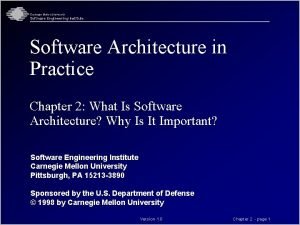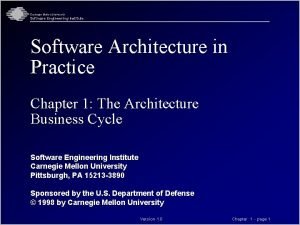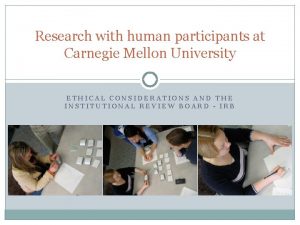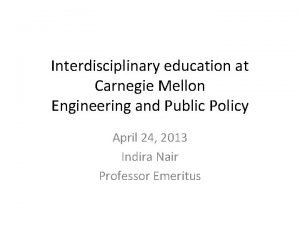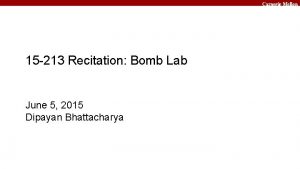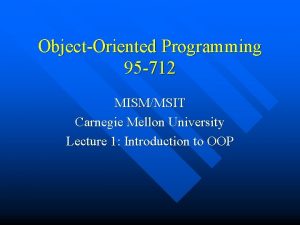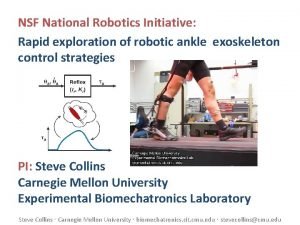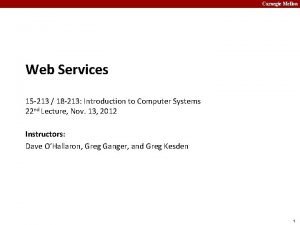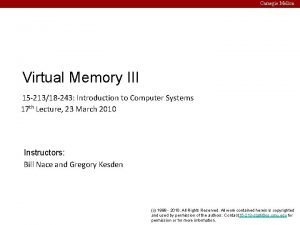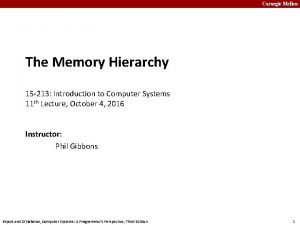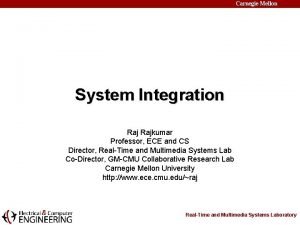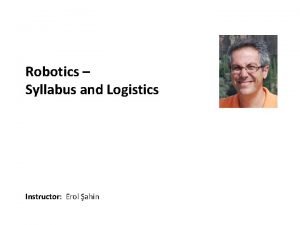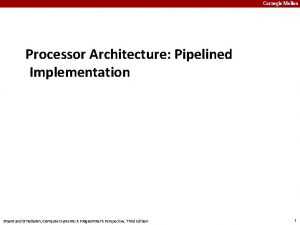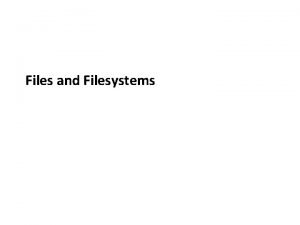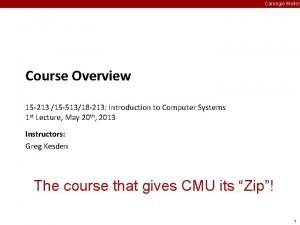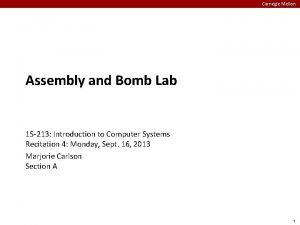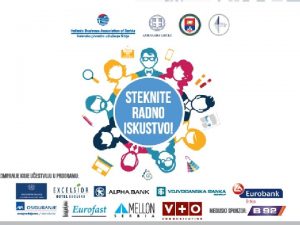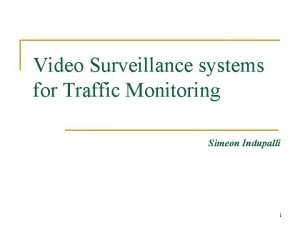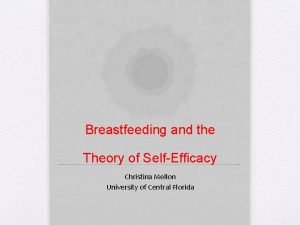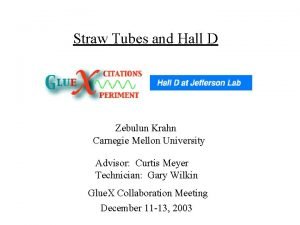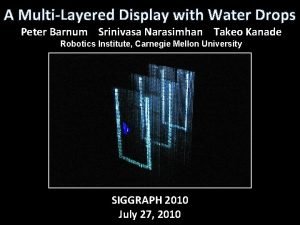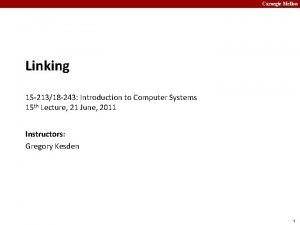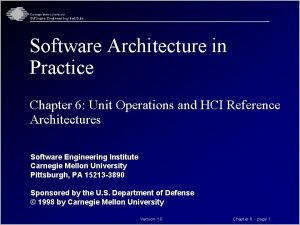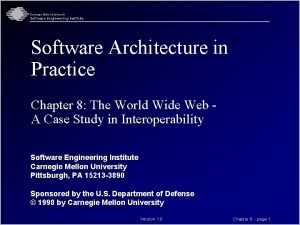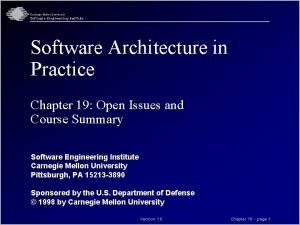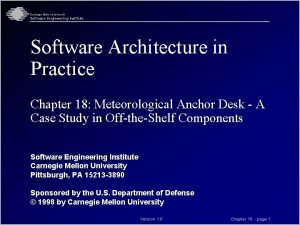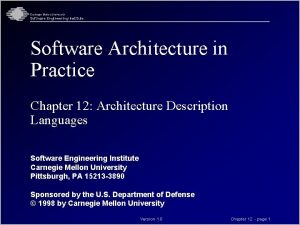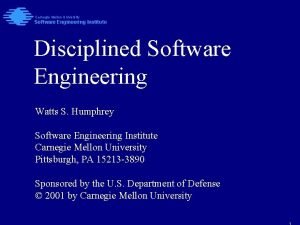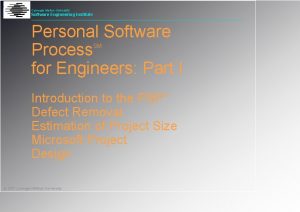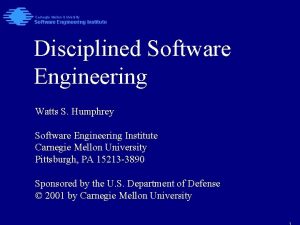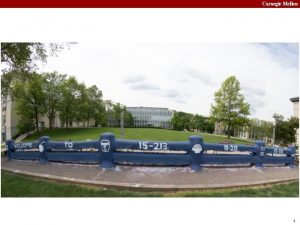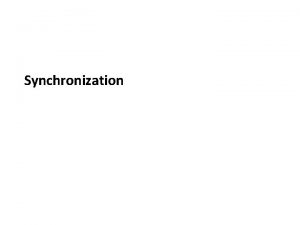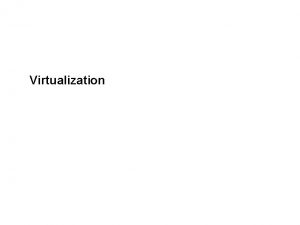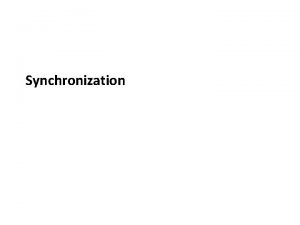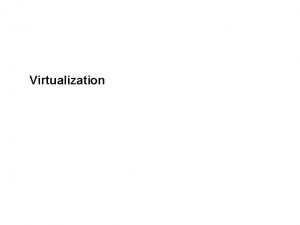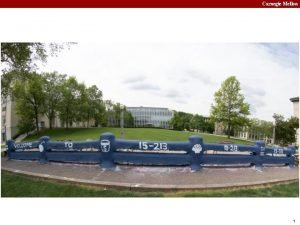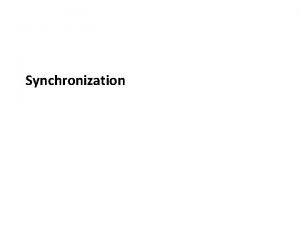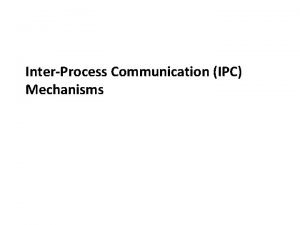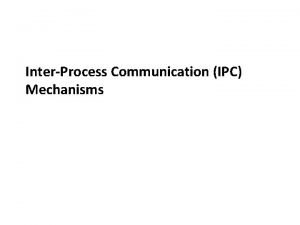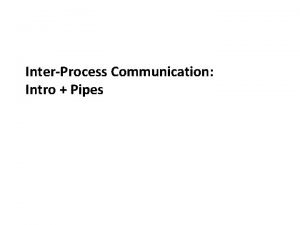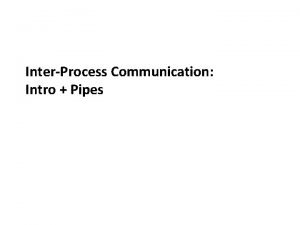Carnegie Mellon University Software Engineering Institute Software Architecture

























- Slides: 25

Carnegie Mellon University Software Engineering Institute Software Architecture in Practice Chapter 9: CORBA - A Case Study of an Industry-Standard Infrastructure Software Engineering Institute Carnegie Mellon University Pittsburgh, PA 15213 -3890 Sponsored by the U. S. Department of Defense © 1998 by Carnegie Mellon University Version 1. 0 Chapter 9 - page 1

Carnegie Mellon University Software Engineering Institute Objectives This lecture will enable students to • understand how the business needs of a consortium led to a particular architecture • understand how the software architecture of CORBA allows program interoperability © 1998 by Carnegie Mellon University Version 1. 0 Chapter 9 - page 2

Carnegie Mellon University Software Engineering Institute Business Motivations The Object Management Group (OMG) was chartered in 1989 to • provide a common software platform in which distributed object-oriented programs can be communicated and interact • create a component-based marketplace for vendors to compete with Microsoft’s Object Linking and Embedding (OLE) © 1998 by Carnegie Mellon University Version 1. 0 Chapter 9 - page 3

Carnegie Mellon University Software Engineering Institute Business Model OMG included most non-Microsoft vendors (IBM, Digital, Sun, HP). They specified the object-management architecture (OMA) and common object request broker architecture (CORBA). © 1998 by Carnegie Mellon University Version 1. 0 Chapter 9 - page 4

Carnegie Mellon University Software Engineering Institute ABC for the OMA Architect’s influences Customer and end user Software community Developing organization Software providers Technical environment OO paradigm Distributed computing Requirements (Qualities) Transparency Evolvability Interoperability Extensibility Architect(s) OMG Architecture OMA/CORBA System Architect’s experience Varied © 1998 by Carnegie Mellon University Version 1. 0 Chapter 9 - page 5

Carnegie Mellon University Software Engineering Institute Quality Goals of the OMA Interoperability: support interoperation of objects implemented by different vendors Evolvability: be responsive to development of new object and distributed systems technologies Extensibility: provide a core set of component integration servers but be extensible to support market niches served by independent software vendors Buildability: be readily constructed with available technology (time to market) © 1998 by Carnegie Mellon University Version 1. 0 Chapter 9 - page 6

Carnegie Mellon University Software Engineering Institute OMA Application objects Object request broker (ORB) CORBAServices © 1998 by Carnegie Mellon University CORBAFacilities Version 1. 0 Chapter 9 - page 7

Carnegie Mellon University Software Engineering Institute Components of OMA -1 CORBA is an architecture specification. It defines a standard architecture and services for OMAcompliant object request brokers (ORBs). The object request broker (ORB) component of CORBA provides communication services, e. g. , remote method invocation, event channels. © 1998 by Carnegie Mellon University Version 1. 0 Chapter 9 - page 8

Carnegie Mellon University Software Engineering Institute Components of OMA -2 CORBAServices: provides universally useful services • naming service • event service • persistent-object services • transaction services • concurrency-control services CORBAFacilities: provides higher level and domain -specific services (not yet well defined) © 1998 by Carnegie Mellon University Version 1. 0 Chapter 9 - page 9

Carnegie Mellon University Software Engineering Institute How OMA Supports Qualities -1 Interoperability • interface definition language (IDL) used as common basis for object interfaces • Internet, inter-orb protocol (IIOP) provides standard “on the wire” representation for request/responses Evolvability: specification partitioned into separately evolvable subcategories © 1998 by Carnegie Mellon University Version 1. 0 Chapter 9 - page 10

Carnegie Mellon University Software Engineering Institute How OMA Supports Qualities -2 Extensibility • CORBA core and CORBAServices provide stable core • CORBAFacilities allow niche-specific extensions Buildability: selected specifications must have commercial-quality implementations within one year of acceptance © 1998 by Carnegie Mellon University Version 1. 0 Chapter 9 - page 11

Carnegie Mellon University Software Engineering Institute CORBA Consists of ORB and various interface mechanisms that allow objects to interact via the ORB Application objects ORB CORBAServices © 1998 by Carnegie Mellon University CORBAFacilities Version 1. 0 Chapter 9 - page 12

Carnegie Mellon University Software Engineering Institute CORBA Architecture Object Clients IDL stubs Static IDL skeleton Dynamic invocation interface ORB interface repository © 1998 by Carnegie Mellon University Dynamic skeleton Basic object adapter ORB core Version 1. 0 Chapter 9 - page 13

Carnegie Mellon University Software Engineering Institute ORB Features ORB interface • identical for all ORB implementations • provides instance binding and object identification services Interface definition language stub/skeleton • specific to each object type • stub called by client • skeleton calls implementation • specified statically Dynamic invocation: methods and parameters determined at runtime © 1998 by Carnegie Mellon University Version 1. 0 Chapter 9 - page 14

Carnegie Mellon University Software Engineering Institute Interface Definition Language All object interfaces are defined in IDL allows • language independence of objects • “wrapping” of legacy systems • explicit publication of interfaces • dependency on only public properties IDL syntax was chosen to resemble that of C++. No overloading of method names is allowed to simplify bindings to existing languages. © 1998 by Carnegie Mellon University Version 1. 0 Chapter 9 - page 15

Carnegie Mellon University Software Engineering Institute Simple Bank Abstraction in IDL interface Account { readonly attribute string name; readonly attribute float balance; void deposit (in float amount); void withdraw (in float amount); }; interface Checking. Account : Account { readonly attribute float overdraft_limit; void order_new_checks(); }; interface Savings. Account : Account{ float annual_interest(); }; © 1998 by Carnegie Mellon University Version 1. 0 Chapter 9 - page 16

Carnegie Mellon University Software Engineering Institute Object Adaptors Object adaptors provide the following services to object implementations. • generation and interpretation of object references • mapping of object references to object implementations • activation and deactivation of object implementations • invocation of methods on object implementations • registration of object implementations • access control for object implementations © 1998 by Carnegie Mellon University Version 1. 0 Chapter 9 - page 17

Carnegie Mellon University Software Engineering Institute Basic Object Adaptor Every CORBA-compliant implementation must have a special kind of object adaptor, basic object adaptor (BOA). The BOA uses the remote procedure call (RPC) model to implement objects, where objects are implemented as server processes. Specifications for BOA were published by OMG, ensuring availability in the marketplace. © 1998 by Carnegie Mellon University Version 1. 0 Chapter 9 - page 18

Carnegie Mellon University Software Engineering Institute How Do Systems Built with Different ORBS Interoperate? CORBA version 1 • did not address the issue of interoperation among different clients of different ORB vendors • allowed faster time to market for ORBs CORBA version 2 (1995) specifies interoperability. Because of the delay in specification, the system must introduce interoperability between vendors without affecting clients of existing ORBs. © 1998 by Carnegie Mellon University Version 1. 0 Chapter 9 - page 19

Carnegie Mellon University Software Engineering Institute CORBA 2 Interoperability -1 Mandated Internet inter-ORB protocol (IIOP) Uses concept of “bridge” protocol adaptors between objects All ORBs must support “half bridges” that convert object requests into IIOP (or IIOP into object requests). Some ORBs use IIOP as a native protocol. © 1998 by Carnegie Mellon University Version 1. 0 Chapter 9 - page 20

Carnegie Mellon University Software Engineering Institute CORBA 2 Interoperability -2 Client request • goes into ORB 1 • converted via half bridge to IIOP • sent to ORB 2 • converted via half bridge from IIOP to object implementation © 1998 by Carnegie Mellon University Version 1. 0 Chapter 9 - page 21

Carnegie Mellon University Software Engineering Institute CORBA/WWW Comparison Both WWW and CORBA address interoperability. WWW • based on data model • relies totally on protocol • has no central control • provides runtime linkage of one page to another CORBA • based on software objects • protocols are adapted both within and between ORBs • has central “software bus” with registration • interfaces are linked at specification time or later © 1998 by Carnegie Mellon University Version 1. 0 Chapter 9 - page 22

Carnegie Mellon University Software Engineering Institute Lecture Summary CORBA was designed to allow interoperation, fast time to market, and evolvability. CORBA provides basic services for object invocation and referencing. IDL allows objects written in multiple languages to be bound to ORB and provides common interfaces independent of ORBs. IIOP allows different ORBs to interoperate. © 1998 by Carnegie Mellon University Version 1. 0 Chapter 9 - page 23

Carnegie Mellon University Software Engineering Institute Discussion Questions -1 1. The discussion of CORBA in this lecture centers around programmatic integration of applications. The discussion of the World Wide Web (WWW) in the previous lecture centered around data integration of applications. What is the major difference between these two approaches? What are the strengths and weaknesses of each? What would be involved in moving CORBA toward a datacentric view or the WWW to a Version 1. 0 Chapter 9 - page 24 © 1998 by Carnegie Mellon University programmatic view?

Carnegie Mellon University Software Engineering Institute Discussion Questions -2 2. What are the issues involved in using CORBA to obtain real-time performance? To put it another way, what would be involved in maintaining real-time quality of service in a distributed object world (as was required in many of the case studies in this book)? © 1998 by Carnegie Mellon University Version 1. 0 Chapter 9 - page 25
 Carnegie mellon software architecture
Carnegie mellon software architecture Carnegie mellon software architecture
Carnegie mellon software architecture Carnegie mellon university research participants
Carnegie mellon university research participants Cmu pitt computational biology
Cmu pitt computational biology Carnegie mellon interdisciplinary
Carnegie mellon interdisciplinary Bomb lab secret phase
Bomb lab secret phase Cmu mism
Cmu mism Randy pausch time management slides
Randy pausch time management slides Kevin thompson nsf
Kevin thompson nsf Carnegie mellon
Carnegie mellon Carnegie mellon
Carnegie mellon Cmu vpn
Cmu vpn Carnegie mellon
Carnegie mellon Carnegie mellon
Carnegie mellon Carnegie mellon
Carnegie mellon Carnegie mellon
Carnegie mellon Carnegie mellon fat letter
Carnegie mellon fat letter Carnegie mellon
Carnegie mellon Assembly bomb lab
Assembly bomb lab Mellon serbia iskustva
Mellon serbia iskustva Carneigh mellon
Carneigh mellon Christina mellon
Christina mellon Bny mellon health savings account
Bny mellon health savings account Zebulun krahn
Zebulun krahn Water mellon
Water mellon Mellon elf
Mellon elf
